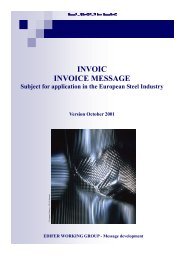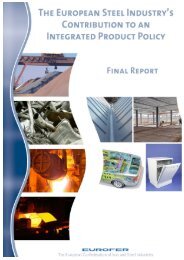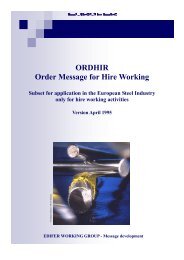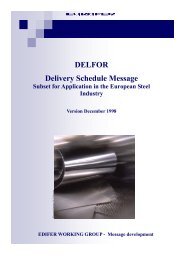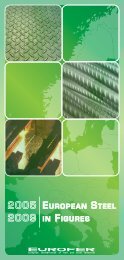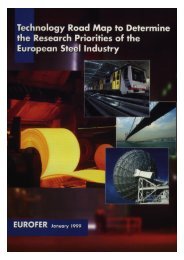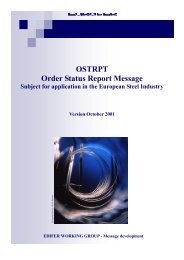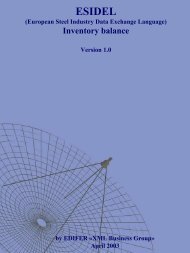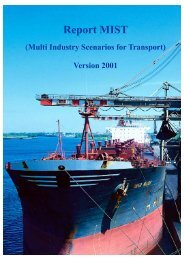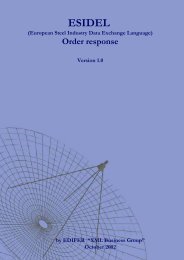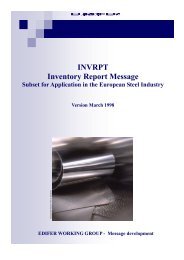manufacture, processing and use of stainless steel - International ...
manufacture, processing and use of stainless steel - International ...
manufacture, processing and use of stainless steel - International ...
You also want an ePaper? Increase the reach of your titles
YUMPU automatically turns print PDFs into web optimized ePapers that Google loves.
• slag formers (titania, silica flour, fluospar, feldspar)<br />
• gas-forming material (carbonates, limestone)<br />
• deoxidisers (ferrosilicon, ferromanganese)<br />
• binding agents (sodium silicate, potassium silicate, or lithium silicate)<br />
• slipping agents (kaolin clay, talc, bentonite clay)<br />
Electrode coatings fall into two types: (i) lime type (containing large amounts <strong>of</strong><br />
limestone <strong>and</strong> fluospar <strong>and</strong> producing globular transfer <strong>of</strong> metal); (ii) titania type<br />
(containing rutile (titania), medium amounts <strong>of</strong> limestone <strong>and</strong> limited quantities <strong>of</strong><br />
fluospar, <strong>and</strong> producing spray-like transfer <strong>of</strong> metal).<br />
Sodium or potassium silicates, which are commonly <strong>use</strong>d as binding agents in the<br />
electrode coating, are the main source <strong>of</strong> alkali ions <strong>and</strong> can lead to the formation <strong>of</strong><br />
soluble hexavalent chromium compounds (sodium or potassium dichromate) in<br />
SMAW fume. Some electrodes have been developed using lithium silicate as an<br />
alternative binding agent; such electrodes have been shown to generate fume with a<br />
lower hexavalent chromium content than those containing sodium or potassium<br />
silicate binders (Soudure Autogéne Francaise 1997).<br />
Flux-cored arc welding (FCAW)<br />
FCAW is an arc welding process that <strong>use</strong>s an arc between a continuous filler electrode<br />
<strong>and</strong> the weld pool. Shielding gas is provided by flux contained within the tubular<br />
electrode; additional shielding may be provided by an external supply. The flux<br />
contains deoxidisers, slag formers, arc stabilisers <strong>and</strong> alloying materials. Small<br />
diameter flux-cored wires using an argon-based shielding gas can involve either short<br />
circuit metal transfer or spray transfer.<br />
Submerged arc welding (SAW)<br />
The SAW process is completely shielded by a layer <strong>of</strong> loose granules <strong>of</strong> flux. Fluxes<br />
<strong>use</strong>d in this process generally contain a mixture <strong>of</strong> slag-forming, deoxidising <strong>and</strong><br />
alloying ingredients, bonded together by a silicate binder. The process <strong>use</strong>s a<br />
consumable solid wire electrode which is continuously fed from a spool.<br />
Plasma arc welding (PAW)<br />
The PAW process <strong>use</strong>s an open, unrestricted gas tungsten arc that is squeezed through<br />
a copper nozzle, resulting in an arc that is longer, thinner <strong>and</strong> more foc<strong>use</strong>d. The<br />
tungsten electrode is non-consumable. Two gases are supplied by the welding torch,<br />
a shielding gas that shields the weld <strong>and</strong> a plasma or orifice gas that controls the arc<br />
characteristics <strong>and</strong> shields the electrode. Shielding may also be supplemented by an<br />
external gas supply.<br />
45



